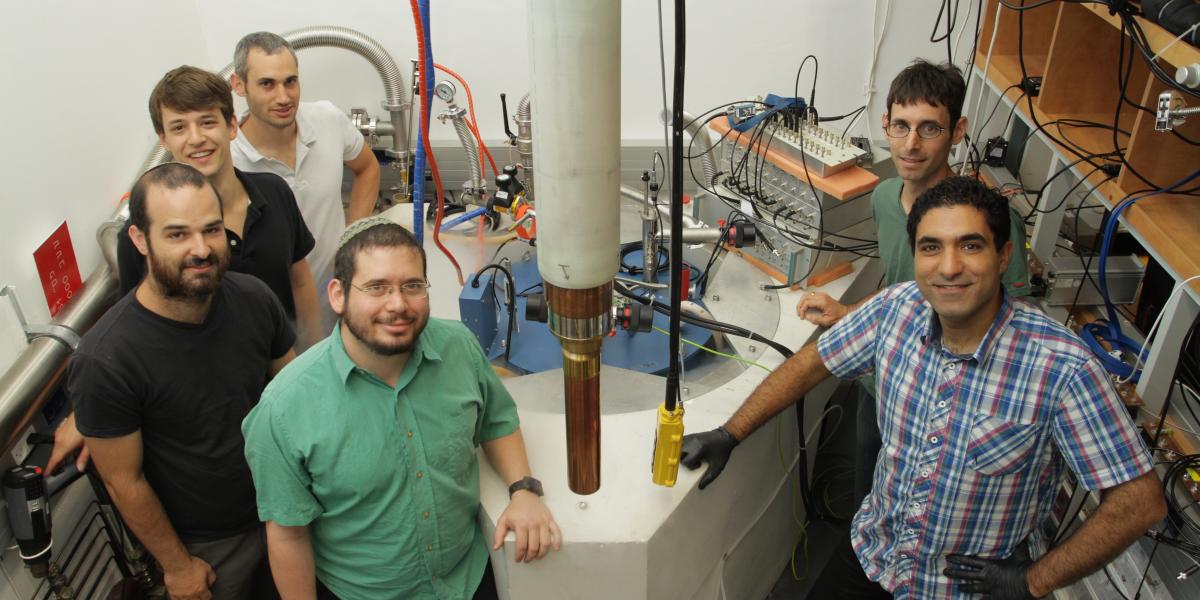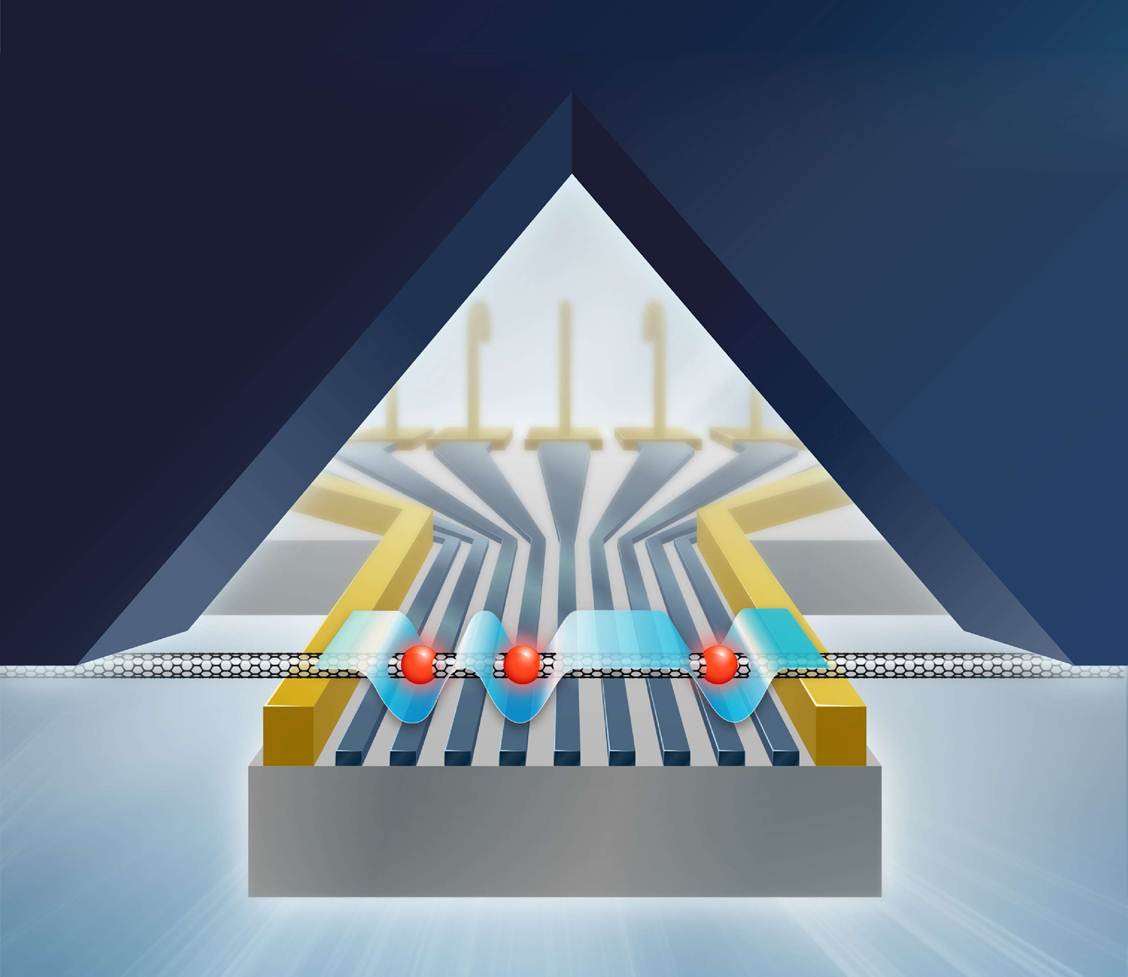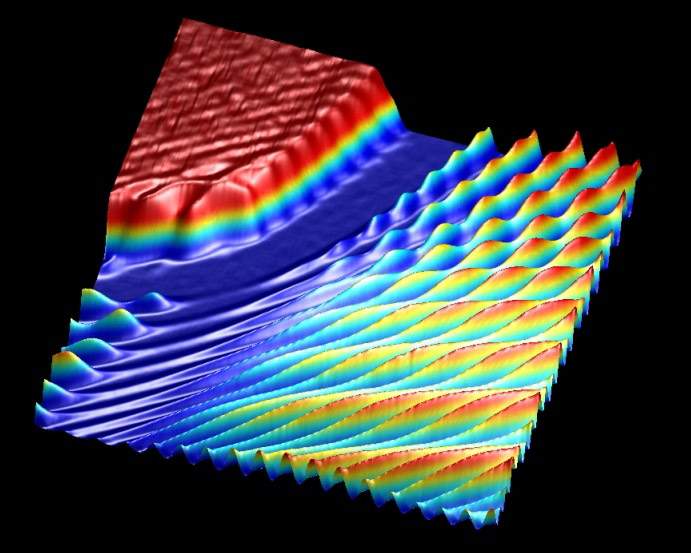In 1934, the physicist Eugene Wigner made a somewhat surprising prediction: Electrons should, in certain circumstances, form a crystal. Everyday crystal structures are based on atoms that line up in a lattice arrangement through a sort of mutual "convenience." Electrons, by contrast, are hard to pin down. These lightweight subatomic particles are generally in constant motion, and their negative electric charges mostly cause them to avoid their fellow electrons as much as possible while they zip around. Yet it was this very trait – repulsion – that Wigner surmised would drive the electrons into a crystal formation. If electrons experience strong mutual interactions, the repulsion could induce them to array themselves in a lattice. One can visualize this, in its simplest, one-dimensional form, as electrons sitting like beads on an imaginary string: Their natural instinct for avoidance would overcome their tendency to move, forcing them to occupy fixed positions along the string.
The trick to creating a so-called Wigner crystal is to find a system in which the electrons strongly interact with one another but, at the same time, interactions with other components of the system do not interfere with the formation of the crystal. Systems based on metal are out, for example, because the electrons in the metal's structure move around relatively freely and there are far too many of them to fit the conditions needed to produce a Wigner crystal. Even if one introduced a small number of electrons into an inert material, the tiniest defect could cause electrons to react with it rather than with one another.
Thus producing a Wigner crystal is a difficult proposition; until now, scientists in search of such an arrangement had seen only hints and clues of its existence, but no one had managed to produce direct evidence of an electron crystal. Now, nearly 80 years after Wigner’s prediction,
Dr. Shahal Ilani of the Weizmann Institute’s Condensed Matter Physics Department, together with his research student Sharon Pecker, and in collaboration with colleagues in the US, Italy and Denmark, has succeeded in creating a Wigner crystal made up of just two electrons – a "Wigner molecule."
For their study, which appeared in
Nature Physics, the team chose a tiny, ultrapure carbon nanotube to host the two electrons. Because the electrons in the carbon atoms are tightly bound within the nanotube structure, the added electrons interact only with each other. Measuring the energy of the system showed the researchers that it was behaving just as a Wigner crystal should – each electron sitting at one end of the tube. The researchers then deliberately squeezed the two electrons to one edge of the nanotube and found that even when pushed together, the electrons still keep a certain distance. "The electrons' behavior when pushed is evidence that the formation of the molecule is a result of an intrinsic electron interaction and not merely an effect of the surrounding environment," says Pecker.
Besides proving Wigner’s long-standing theoretical prediction, says Ilani, the work is an important demonstration of an extremely clean, nanotube-based system enabling the controlled manipulation of delicate electronic states. "If we can manage to extend the control over two electrons to independent control over many electrons," says Ilani, "this could unleash a new wave of precision experiments in nanotubes, using them as the pristine condensed-matter laboratory for studying fundamental quantum mechanical phenomena on the nanoscale." This idea motivated Ilani's group to come up with a new way of fabricating carbon nanotubes. Their invention,
recently described in
Nature Nanotechnology, generates complex, ultraclean devices in which many electrons can be controlled individually.
Until now, methods for producing nanotube-based devices have involved creating the two components of a device – nanotubes and an electronic circuit – together. Such devices are limited: Since each of these tasks, alone, is difficult, combining them makes the production of complex devices impossible. "Our new technique solves this fundamental problem by separating the fabrication of devices into its two independent parts," says research student Jonah Waissman. "On one chip we grow nanotubes and on another we fabricate an electrical circuit, enabling us to make each of them as flawless as possible. Then we use a specially-designed scanning microscope to combine the two parts to form a fully-functional, complex device." Among other things, a single circuit may now incorporate several nanotubes. "Our new fabrication technique leaves very little to chance," says Ilani, "since we ensure that both the nanotube and the circuit are perfect well before the experiment starts."
With their new devices, Ilani and his group plan to reveal fascinating new aspects of Wigner molecules comprised of ever more electrons – hopefully approaching the full-fledged quantum crystal. But the new technique opens up a much wider array of experimental possibilities: Carbon nanotubes have many unique properties, electronic as well as mechanical, so the new system presents a unique laboratory for exploring quantum mechanics. "Having control over so many degrees of freedom," says Ilani, "we can now devise experiments on the nanoscale that were unimaginable before."
Dr. Shahal Ilani is the incumbent of the William Z. and Eda Bess Novick Career Development Chair.



